Spam Onigirazu is a delicious Japanese rice sandwich with a winning combination of fried eggs, furikake, and Spam wrapped in steamed rice and crispy nori. You‘ll want to sink your teeth into this yummy treat! It‘s perfect for a quick meal or snack on the go.
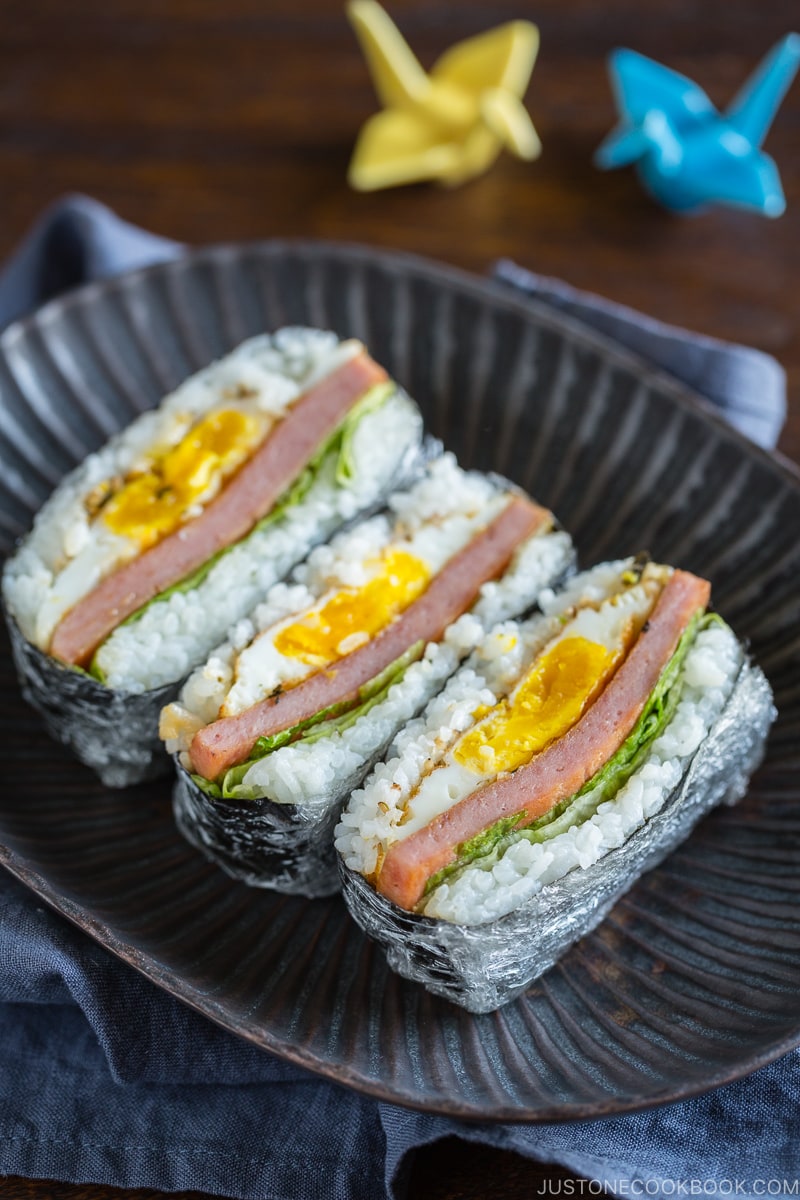
If you love a popular Hawaiian favorite SPAM® Musubi, you will LOVE this SPAM® Onigirazu (スパムおにぎらず). The ingredients are similar to classic musubi; all you need is SPAM® product, rice, and a nori (seaweed) sheet. The biggest difference is that you could add more fillings in Onigirazu, and today I added lettuce and a fried egg to make it more like a breakfast dish. This combo of deliciousness is portable and hearty enough to fill a hungry stomach any time of the day. You’ll love it for a picnic, road trip snack, or plane food too!
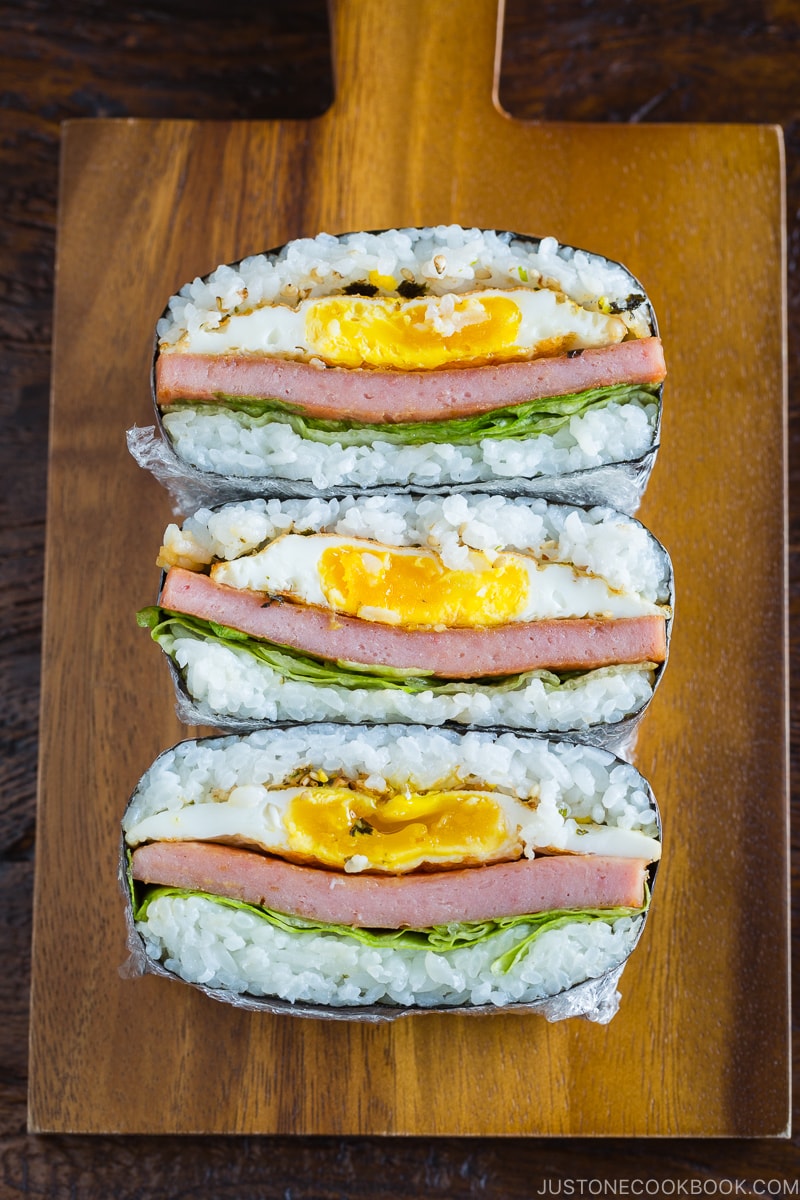
What is Spam Musubi?
A popular snack and lunch dish in Hawaii, SPAM® Musubi is made of a thinly sliced grilled SPAM® product on top of rice pillow. The SPAM® product and rice are wrapped together with nori (seaweed sheet), almost look like Tamago Sushi. It is sweet, salty, filling and extremely addicting. If you like to get creative, check out the cuter version of Piggy SPAM® Musubi which I made a while ago to surprise my children.
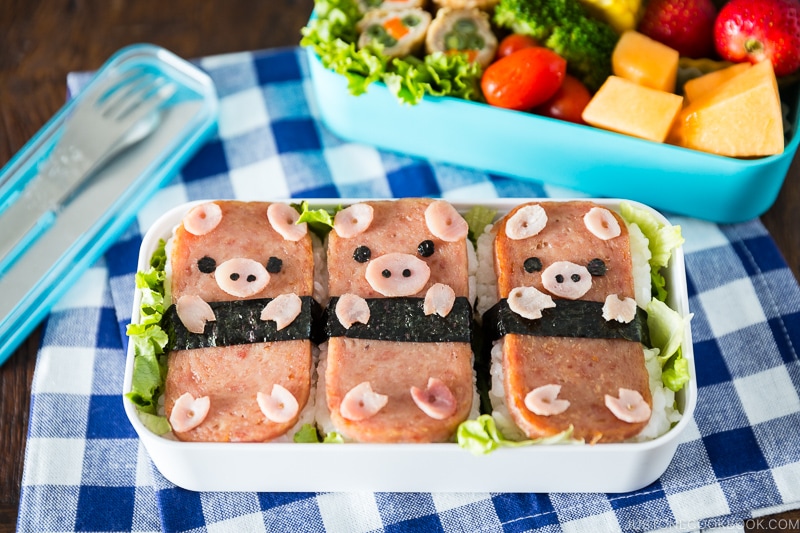
How To Make Spam Onigirazu
SPAM® Onigirazu is a little bit fancier version of SPAM® Musubi. You could add more ingredients and make it more delicious as onigirazu holds more fillings inside.
If you’re not familiar with onigirazu, it’s basically a rice sandwich; instead of making a triangle/round onigiri (omusubi), we make a rice sandwich with more fillings. I made a video on how to make it here, and I have also shared my Chicken Katsu Onigigirazu and Bulgogi Onigirazu recipes on my blog (and more recipes coming soon!).
As the SPAM® product is a bit on the salty side, I like to add a fried egg to make it more balanced, while lettuce (especially iceberg lettuce) gives a crunchy and refreshing texture.
SPAM® product is usually cooked with soy sauce for musubi, so I season the SPAM® product the same way in this recipe. Soy sauce, mirin, and sake are the most important 3 ingredients for typical Japanese flavors.
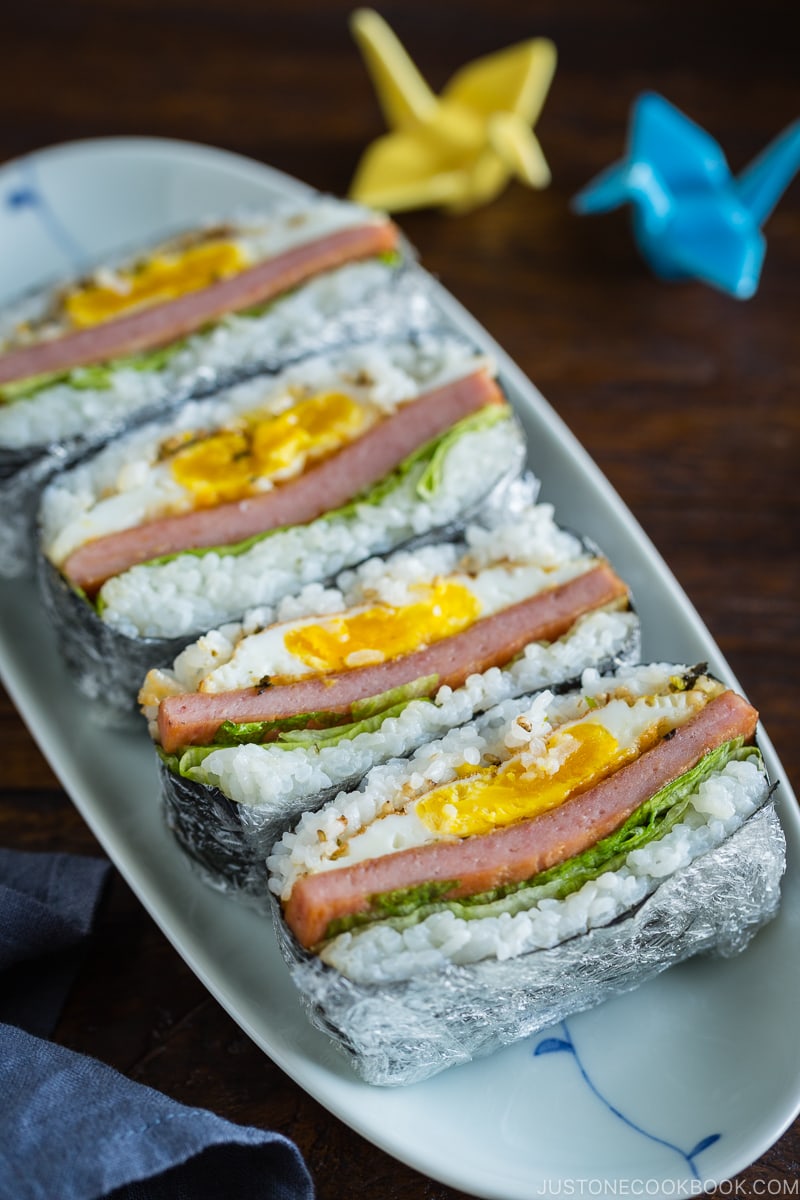
Hawaiian Foods Week with Spam Onigirazu
My children absolutely love onigirazu and it’s one of their most requested lunch items. As next week (June 12 – 18) is Hawaiian Foods Week, I got the idea for this recipe while grocery shopping and saw SPAM®. As many of you know, SPAM® products are a part of life in Hawaii. It’s served everywhere, from grocery stores, delis to fancy restaurants. Even McDonald’s features several SPAM® items on their breakfast menu.
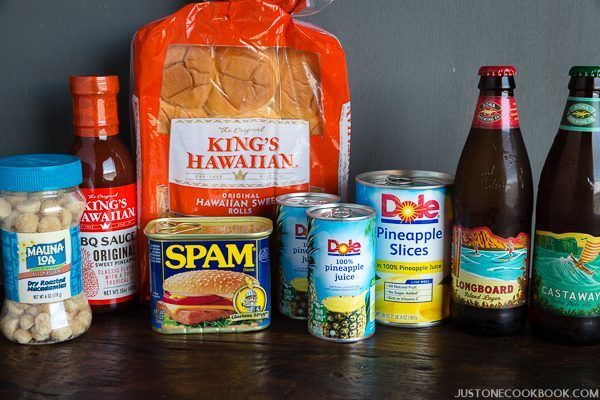
Starting next week, I will be celebrating Hawaiian Foods Week with many of the brands you know and love, which include King’s Hawaiian, Dole, SPAM®, Kona Brewing Co., and Mauna Loa.
After making the onigirazu for my children, I made several sandwiches with King’s Hawaiian rolls, SPAM® product, and King’s Hawaiian BBQ sauce for Mr. JOC. He thoroughly enjoyed the combination, and it’s now made the list as one of our quick meal ideas.
What are your favorite Hawaiian foods? Share in the comment below! 🙂
Using an Onigirazu Mold
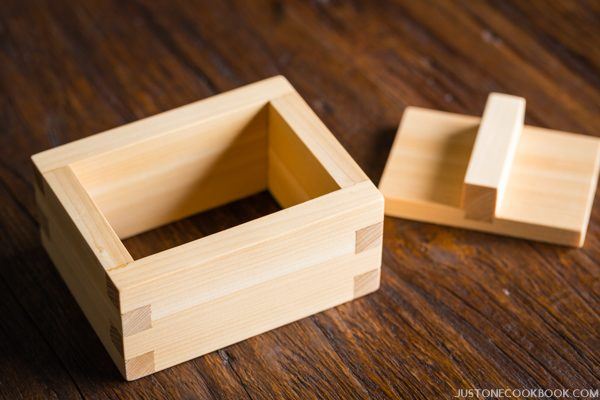
Mark, one of JOC readers from Oregon, kindly sent me this beautiful onigirazu mold that he handcrafted. It’s made of Port Orford cedar and there is not a single nail used in this mold. Thank you, Mark! If you want to purchase this mold, please click onigirazu mold page for details.
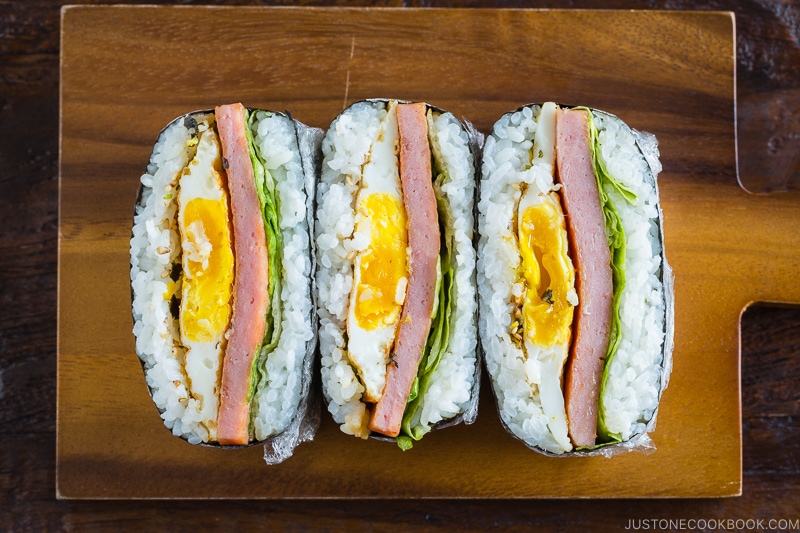
Sign up for the free Just One Cookbook newsletter delivered to your inbox! And stay in touch with me on Facebook, Pinterest, YouTube, and Instagram for all the latest updates.
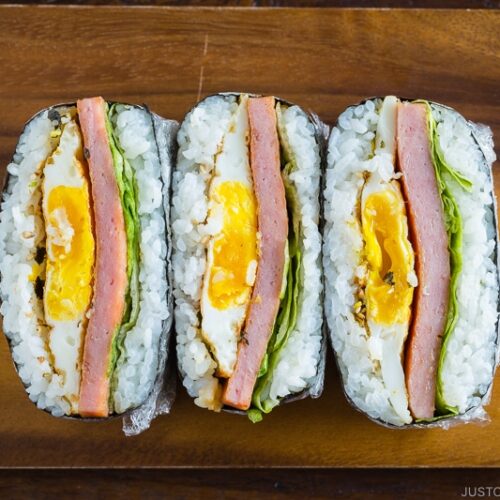
Spam Onigirazu
Ingredients
- 6 large eggs (50 g each w/o shell)
- 1 Tbsp neutral oil (to cook the eggs, per batch)
- 1 small can SPAM® (7 oz)
- 6 sheets nori (dried laver seaweed)
- 3 cups cooked Japanese short-grain rice (about 450 g)
- Diamond Crystal kosher salt
- 1 Tbsp furikake (rice seasoning)
- 6 leaves lettuce (I used iceberg lettuce for the crunch)
Instructions
- Before You Start: Gather all the ingredients. For the steamed rice, please note that 1⅛ cups (1½ rice cooker cups, 225 g) of uncooked Japanese short-grain rice yields about 3⅜ cups (495 g) of cooked rice. See how to cook short-grain rice with a rice cooker, pot over the stove, Instant Pot, or donabe.

- For the 6 large eggs (50 g each w/o shell), heat 1 Tbsp neutral oil over medium-high heat in a frying pan and cook the eggs as you like; cook the eggs in batches if necessary. (I cooked the egg over hard, which is a fried egg turned over and cooked until the yolk is solid.) Transfer to a plate when they are cooked.

- Meanwhile, remove the meat from 1 small can SPAM® (7 oz) and cut into long slices ¼ inch (6 mm) thick. You’ll get about 6–7 slices. Once the eggs are cooked, add the Spam slices to the pan and cook both sides until nicely browned. Transfer the Spam slices onto a plate.

- Turn down the heat to medium low and add 1 Tbsp mirin, 1 Tbsp sake, and 1 Tbsp soy sauce. Mix well quickly.

- Transfer the Spam slices back to the pan and coat well with the sauce.

To Wrap the Onigirazu
- Place plastic wrap on a working surface and put a sheet of nori seaweed on top (shiny side facing down), with a corner pointing up. Evenly spread a thin layer of steamed rice (about ¼ cup) in a thin layer and form into a square shape in the center of the nori sheet. I’m using an onigirazu mold.

- Sprinkle a little bit of Diamond Crystal kosher salt and 1 Tbsp furikake (rice seasoning). Salt is added to prevent the food from spoiling as we eat onigiri, onigirazu, and bento at room temperature and typically without refrigeration.

- Place the fried egg and Spam slice on top.

- Place 1 leaf lettuce and thin layer of steamed rice on top, maintaining a nice rectangular/square shape.

- Now, if you have an onigirazu mold, pull up the mold carefully. Remember to moist the “lid” before you press down so rice does not get stuck to it.

- Bring left and right corners of nori sheet towards the center. Fold gently but tightly to wrap around the layers at the center.

- Then bring bottom and top corners towards the center. Continue to fold gently but tightly around the layers. Make sure the rice is tucked in nicely.

- If you‘d like your onigirazu to showcase the filling after cutting it in half, mark the slicing direction with a piece of rice or lettuce strip perpendicular to the filling. When you add the filling, you can decide which way you want to cut it so the layers look the best when revealed. I cut mine in half lengthwise.
- Wrap tightly with plastic wrap. Set aside for 5 minutes with the nori’s seam side down.

To Serve
- Cut the onigirazu with a sharp knife (following the mark that tells you which direction to cut). Run your knife in running water before cutting so that the cross-section will be clean.

To Store
- If you plan to make this the previous night, wrap the onigirazu with a kitchen towel and keep in the refrigerator overnight. The towel will prevent the rice from getting hard from the cold temperature. Eat within 24 hours.
Nutrition
Full Disclosure: This is a sponsored conversation written by me on behalf of King’s Hawaiian. The opinions and text are all mine.
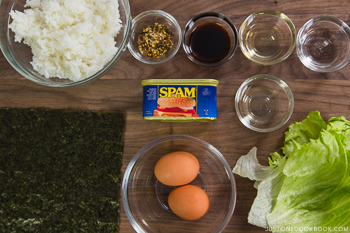
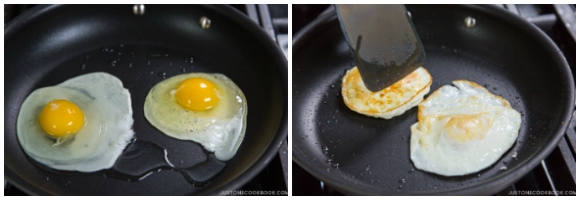
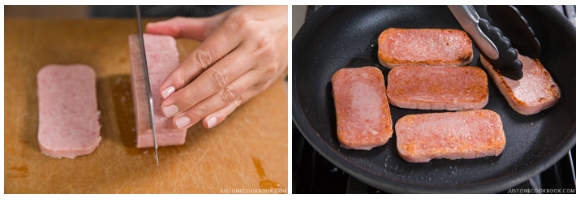
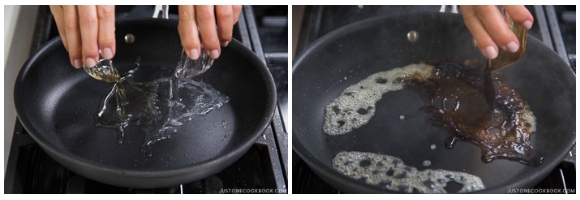
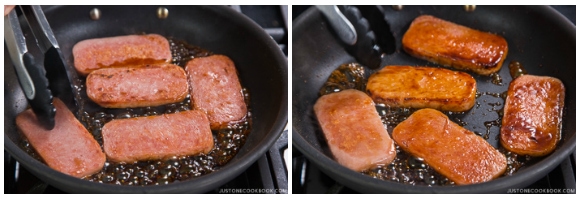
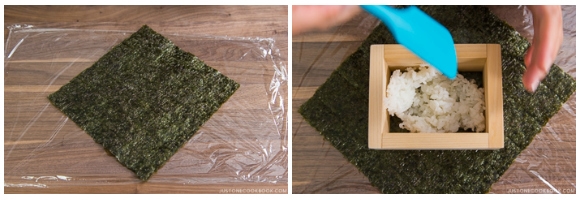
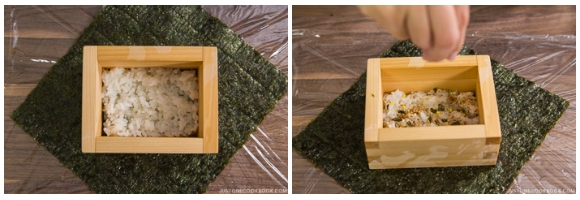
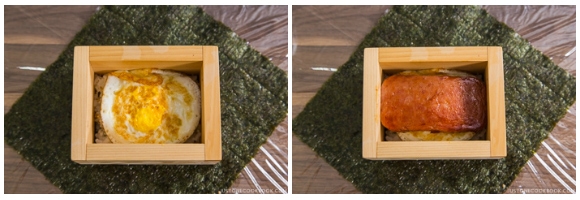
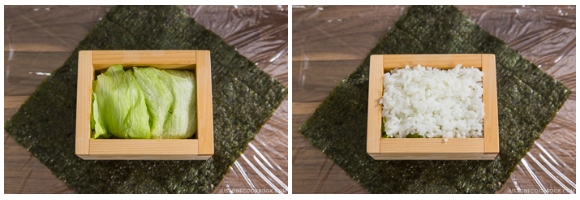
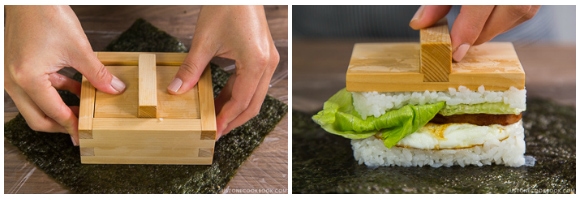
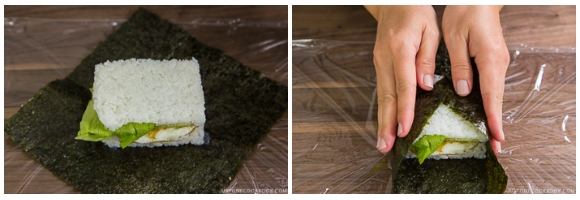
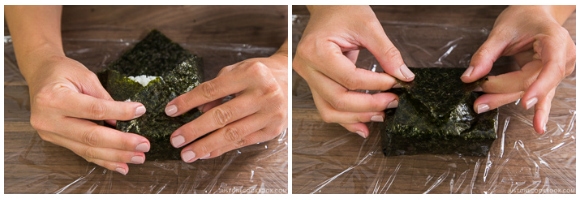
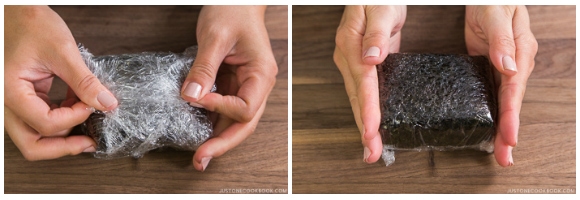
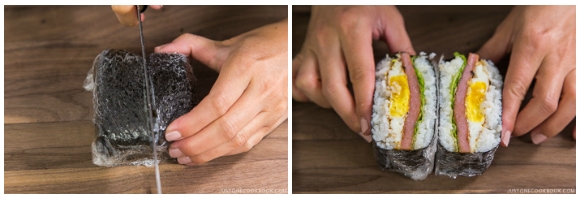










Delicious! Not sure if I wrapped correctly because I don’t have the mold.
Hello, Cathy! Thank you for trying Nami’s recipe and sharing your Onigirazu photo!
It looks great! If you cut them long horizontally next time, it will look like Nami’s. 😊
If you like, use a spam can as a mold to shape the rice in the center of the Nori, then top it with other ingredients. We hope this works!
My son really enjoys this! Thank you for sharing the recipe ♥︎
Hi Claire! Wow! Thank you so much for the compliment!
We are glad to hear you and your son enjoyed Nami’s recipe! ☺️
i make spam musubit for my kids field trips but this is the first time making spam onigirazu. it’s a nice addition and makes their lunch more filling!
Hi Yumi! We hope your kids enjoyed the new addition.😊
Thank you so much for trying Nami’s recipe and sharing your Onigirazu photo with us.
I had been wanting to make this for awhile and finally got the chance. Quite fun to make! I used Spam with bacon for my onigirazu -works well with the eggs, haha. I then used the bottom of the can to press it down before wrapping it.
I only got a photo of one of them (not even the best one!) because they went too quick! I almost got NO photos! This recipe is a keeper!
Hi Heather! Thank you for sharing your Spam Onigirazu photo with us! Looks delicious!
We are glad to hear you had fun making them. Happy Onigirazu!😁
A really fun lunch food that my husband and I loved. This was my first try making onigirazu. I got the hang of how to wrap them by the third one. It went better when I did not stuff it with too much lettuce or rice. I used my homemade furikake that I made yesterday using Nami’s recipe, too. I cut mine in half the short way, but next time, I’ll cut them the long way so they look more like the recipe photo. Thank you!
Hello there, Kumi! Thank you for taking the time to tell us about your experience! Your Onigirazu is beautiful!
Here’s a link to Nami’s other Onigirazu recipes. We hope you enjoy building the various variations! 😁
Have fun making Onigirazu!
https://www.justonecookbook.com/#search/q=onigirazu
A little messy but yummy!!😋😋
Hi Mariko! Thank you so much for trying Nami’s recipe and sharing the photo of your Spam Onigirazu!
We are glad you enjoyed it!